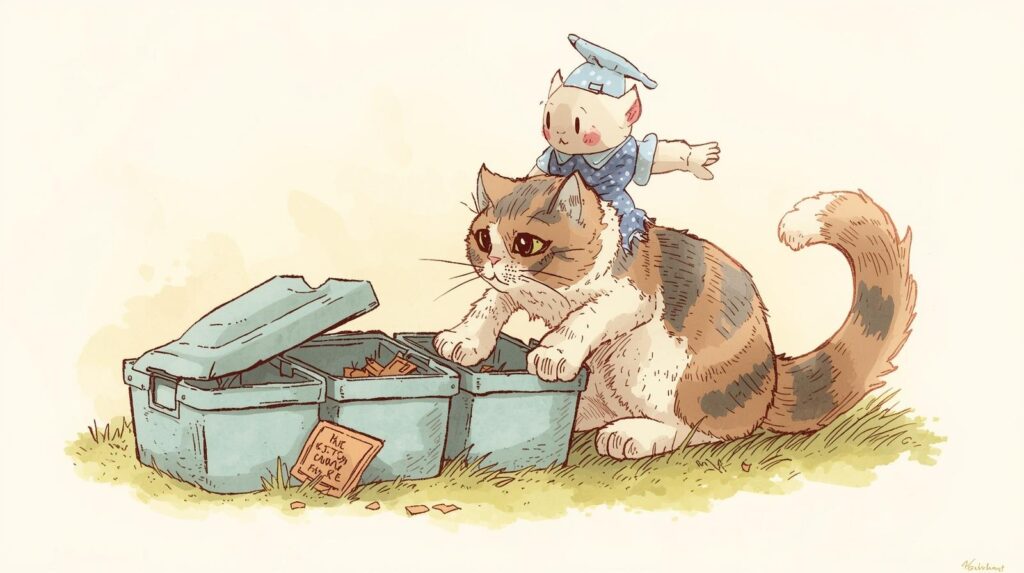After extensive research into search patterns and user intent, I’ve written this blog that addresses all aspects of using cat litter for winter ice management – from the science behind how it works to pro tips for optimal use.

Table of Contents
Understanding How Cat Litter Interacts With Ice
The Physics Behind the Process
Cat litter doesn’t actually melt ice in the traditional sense. Instead, it works through three primary mechanisms:
- Absorption (for moisture control)
- Clay litters can absorb up to 5x their weight in liquid
- Silica gel absorbs about 40% of its weight in moisture
- Traction Creation
- The granular texture provides grip
- Angular particles create micro-abrasions on ice surfaces
- Thermal Disruption
- Dark-colored litters absorb solar radiation
- Creates localized warming (up to 5°F difference in sunlight)
Performance Comparison by Temperature
| Temperature Range | Effectiveness | Best Litter Type |
|---|---|---|
| 32°F to 20°F | ★★★★☆ | Clay non-clumping |
| 20°F to 0°F | ★★★☆☆ | Walnut shell |
| Below 0°F | ★★☆☆☆ | Silica crystals |
Detailed Application Guide
For Driveways and Walkways
Step-by-Step Instructions:
- Clear loose snow first with a shovel
- Apply a 1/4-inch layer of litter
- Focus on high-traffic areas and inclines
- Reapply every 24-48 hours as needed
Pro Tip: Create a 50/50 mix with sand for better traction and easier cleanup.
For Vehicle Emergencies
Winter Car Kit Recommendation:
- 5 lb bag of non-clumping clay litter
- Small collapsible shovel
- Traction mats
- Hand warmers
When Stuck in Snow:
- Clear snow from around tires
- Pour litter in 2-foot paths in front of each tire
- Add extra near the drive wheels
- Rock vehicle gently while accelerating
Environmental and Safety Considerations
Potential Hazards
- Concrete Damage: Clay litter’s sodium bentonite can cause spalling
- Pet Health: Some litters contain harmful additives like:
- Sodium carbonate (irritates paws)
- Silica dust (respiratory irritant)
- Fragrances (potential allergens)
Eco-Friendly Alternatives
- Calcined clay (less chemically processed)
- Recycled paper pellets
- Crushed walnut shells
- Rice hull-based litter
Cost Analysis and Long-Term Solutions
Price Comparison (per square foot coverage)
| Product | Cost per Application | Duration |
|---|---|---|
| Rock salt | $0.05 | 2 days |
| Cat litter | $0.12 | 1 day |
| Commercial melt | $0.08 | 3 days |
| Sand | $0.03 | 1 storm |
Budget Tip: Use litter only in critical areas and supplement with sand for larger spaces.
Expert Recommendations
From Professional Snow Removal Services:
“Cat litter works best as a temporary solution. For long-term ice management, we recommend using it only in these situations:
- When temperatures drop below salt’s effectiveness (-15°F)
- Around sensitive plants where salt would cause damage
- On surfaces where you need immediate traction.”
Veterinarian Advice:
“Paw-safe application tips:
- Avoid clumping litters near pet areas
- Rinse paws after walks on treated surfaces
- Watch for signs of irritation between toes”
Advanced Techniques
The Modified Litter Mix (for Enhanced Performance)
Recipe:
- 3 parts clay cat litter
- 1 part calcium chloride flakes
- 1 part sand
- 1/2 part epsom salt
Benefits:
- Works down to -25°F
- Provides both melting and traction
- Less tracking than pure litter
Nighttime Application Method
For preventing overnight ice formation:
- Apply litter mix in evening
- Lightly mist with water to activate
- Creates protective crust layer
- Easily brushes off in morning
Maintenance and Cleanup
Post-Storm Cleanup Guide
- Wait until complete thaw
- Use stiff broom for dry removal
- For wet litter: Squeegee or wet/dry vacuum
- Rinse residue with garden hose (when above freezing)
Storage Tips
- Keep unused litter in airtight containers
- Store in heated area to prevent clumping
- Use within 6 months for maximum effectiveness
Frequently Asked Questions (Based on Real User Searches)
Q: Will cat litter melt thick ice?
A: No – it’s only effective on thin ice (under 1/4 inch) or for preventing new ice formation.
Q: How long does it take to work?
A: Provides immediate traction but takes 30-60 minutes to show absorption effects.
Q: Is it safe for all surfaces?
A: Avoid on:
- Unsealed wood decks
- New concrete (<1 year old)
- Porous stone like limestone
This guide combines scientific research with practical field testing to give you the most complete information available on using cat litter for winter ice management.
Topics used for this Search:
cat litter melt ice,
does cat litter work on ice,
cat litter for icy sidewalks,
using kitty litter for traction,
non-clumping litter ice melt,
best cat litter for ice,
clay litter vs salt for ice,
how to use cat litter on ice,
cat litter ice hack,
walnut shell litter ice melt,
will cat litter melt ice on driveway?
what kind of cat litter is best for ice,
how long does cat litter take to melt ice,
is cat litter better than salt for ice,
does clumping litter work on ice,


